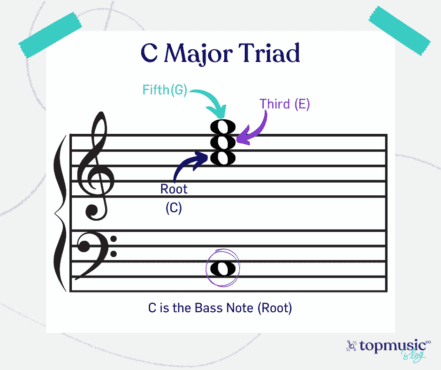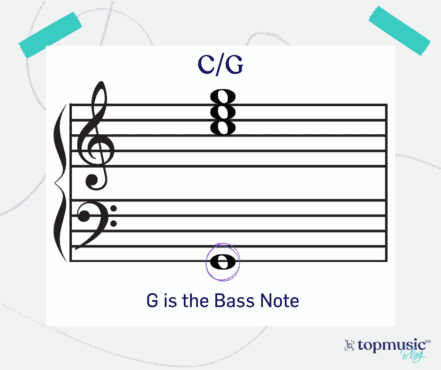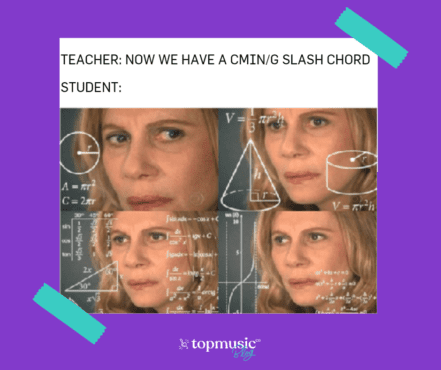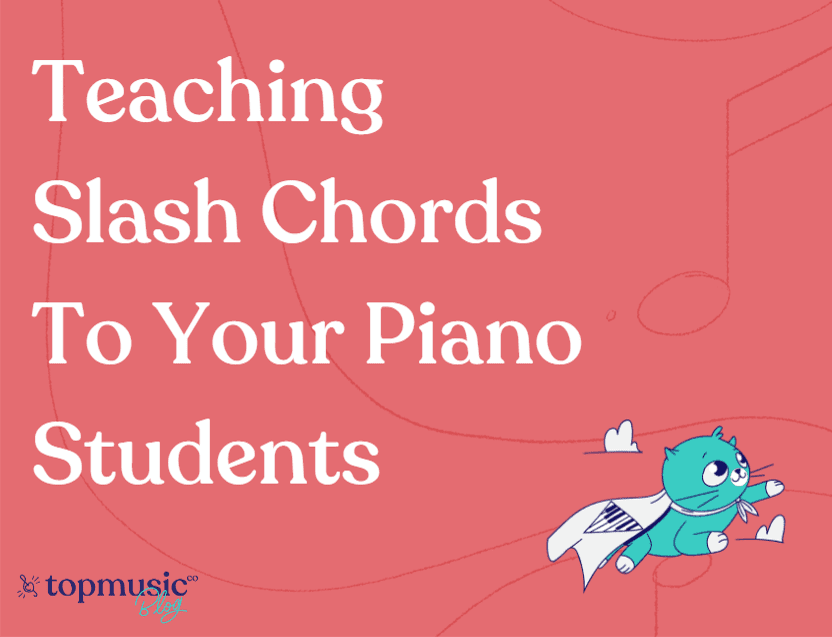Slash chords can look confusing, but when it comes to playing them on the piano they’re not too tricky! Check out our guide to slash chords.
Slash chords. They’re those confusing-looking chord symbols you find on lead sheets. They look like G/B C/E Am/C
If you’re teaching your students how to play from lead sheets (and you definitely should!) you will definitely come across slash chords. If the sight of them makes you shy away from using lead sheets, worry no longer! We’ll help you understand what they are, why they’re useful, and how to play them.
Table Of Contents:
To understand slash chords, let’s quickly refresh our memory of the structure of chords, specifically triads (three-note chords)
Chords are built up from the root (the lowest note). The root note is also the letter used to represent the chord.
For example, in C and C min the root note is ‘C’ (even though they’re different chords).
The remaining notes in a triad are called third and fifth (because they’re a third and a fifth about the root note. Makes sense!)
For example, the C Major triad is made up of C (root) – E (third) – G (fifth)

If you want a more in-depth look at chords, check out How To Teach Piano Chords: The B-S Method
A slash chord simply has a different note at the bottom. The root note is replaced. We know which note to use because it’s the one after the slash.
They are written: Main Chord / Bass Note.
For example, C/G would mean C is the main chord, and G is the bass note (instead of C).
With me so far? Good!
We’ve established that slash chords look confusing and intimidating. However, they’re pretty straightforward to play! (Phew!)
The letter before the slash is the main chord. We’ll play that with our right hand.
The letter after the slash tells us the bass note. As it’s referred to as ‘the bass note’ it’s quite often played separately from the main chord. This could either be by a bassist if you’re in a band, but if you’re a solo pianist you can just play it with your left hand.
We’ll use C/G as our example again.
C is the main chord (before the slash) so we’ll play the C major triad (CEG) in our right hand.
G is the bass note (after the slash) so we’ll play G in our left hand.

Pretty straightforward, right?
To make these chords easier to understand (and to demonstrate to your students) you can think of them as:
As we tell our students whenever they ask, “But whyyyyy does (insert any theory topic they find hard) exist?”, they’re not designed to make playing the piano harder!
There are many benefits to slash chords:
Have we won you over on the benefits of slash chords? Good!
I can! And you’ll be surprised at how many times you’ve heard slash chords in the wild and not even realized!
A Whiter Shade of Pale (Annie Lennox)
Listen out to the intro. You can hear the descending bass line. You know what that is? Slash chords!

Other examples of slash chords in action include:
There’s something about playing chords that piano students just love. Is it the fuller sound? Is it the feeling of satisfaction as they play multiple notes? Whatever it is, they can’t get enough of them!
To embrace their love of chords, we created the course 4 Chord Composing.
This course guides you through teaching your students the basics of chords all the way to creating their own complex chordal compositions. And let us tell you, it’s an absolute winner with students!
4 Chord Composing can be bought as a one-off purchase, BUT it’s also free to Studio and Evolution Members of TopMusicPro.
